Squats are the crowned king of leg exercises. Whether you want to build bigger quads, glutes, and hamstrings, increase your lower body strength, jump higher, run faster, or just get lean and tone up, squats will help.
In fact, entire workouts have been written around the mighty squat, such as the old-school 20-rep squat routine and the Bulgarian method, which involves squatting almost every training day.
However, as obviously awesome as the squat is, it’s not the only way to train your legs. In fact, in some instances, there may be better exercises.
For example, as well as working your legs, squats are pretty tough on your lower back. As such, you may find that your back fails before your legs, leaving your muscles understimulated.
Then there is a balance and mobility needed for squats. Some lifters, especially beginners, are not limber enough to squat with good technique.
Safety can also be an issue. For example, you should always do heavy squats in a power rack so that if you cannot complete a rep, you won’t get pinned under the bar.
Finally, doing nothing but squats can soon become boring, and that can reduce workout motivation. Squats only work if you do them – not just for a week or a month but for years and years!
The good news is that there are exercises you can do alongside or even instead of squats that are almost as effective. At the top of this list is leg presses.
Leg Press Benefits
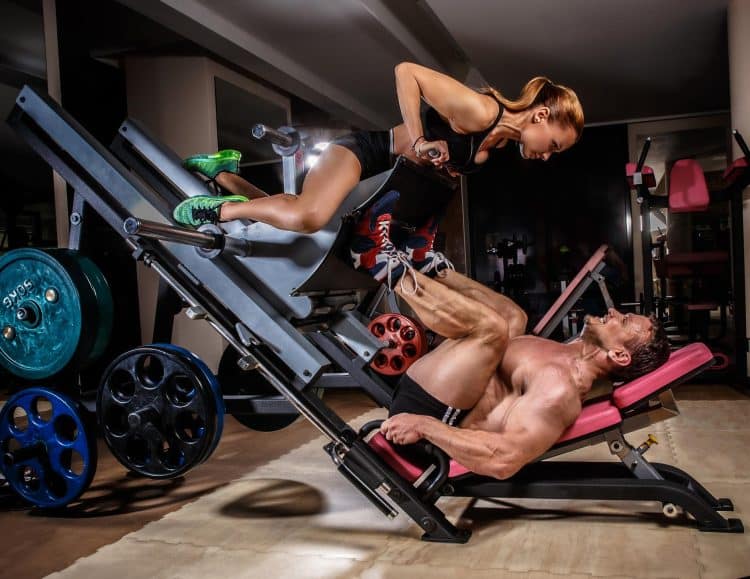
Leg presses involve a similar joint movement to squats and target many of the same muscles. However, the weight is guided, so you don’t need the best joint stability and balance to do them.
Most leg press machines also have safety handles so you can lock the weight in place and stop it crashing down on you if you train to failure. Plus, you can move your feet forward, backward, in, or out to hit different parts of your legs.
But how much does a leg press weigh when it’s empty? And how much weight do you actually lift when leg pressing? We reveal the answer!
How Much Does A Leg Press Weigh When It’s Empty?
Needless to say, you should always pay attention to how much weight you’ve loaded onto your leg press before using it. That way, you won’t inadvertently find yourself trying to lift more weight than you can safely manage.
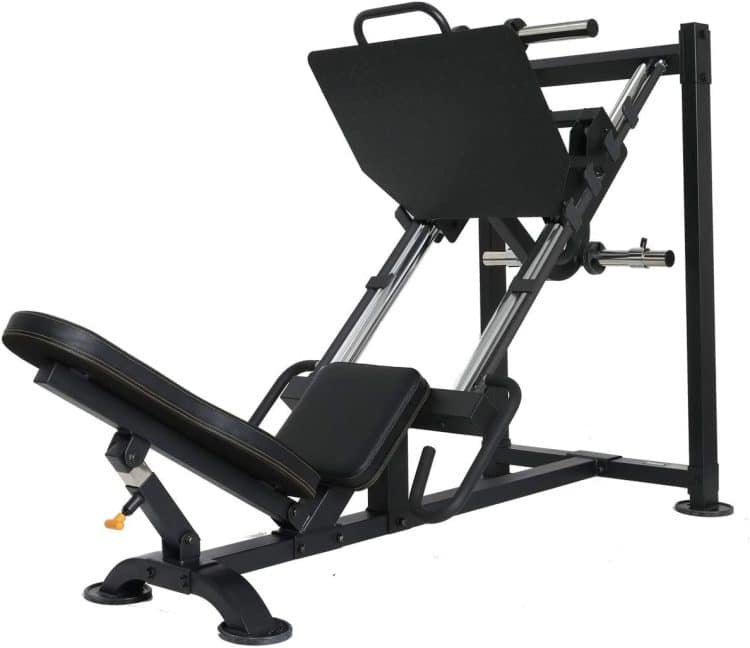
Bumper plates are a uniform size and it’s very easy to think you’re about to lift one weight and for it to be much heavier than expected. Check what’s written on the plates, and don’t assume you know what weight is on the leg press just by counting plates. They could be 25-pounders, or they weigh 50 pounds.
That said, the weight on the leg press is not just determined by the number of weight plates but by the design of the machine itself.
The weights are loaded onto something called a weight carriage or sled, which is the part of the leg press that moves. This is a very strong part of the machine, so it tends to be quite heavy. As such, the weight of the sled contributes toward the total amount of weight you end up lifting.
It can be helpful to know how much an empty leg press carriage weighs. That’s especially true for beginners where even just the carriage could prove too heavy. However, most lifters don’t include the weight carriage and only count plates.
Unfortunately, leg press weight carriages vary from manufacturer to manufacturer and machine to machine. Unlike barbells, which tend to be made to a standard set of specifications, there is no official weight for leg press sleds.
That means that the starting weight of a leg press depends on the make and model of the machine you are using.
Some examples include:
- Cybex Leg Press: 125lbs/57kg
- Hammer Strength Leg Press: 118lbs/54kg
- Life Fitness Leg Press: 103lbs/47kg
- Precor Leg Press: 136lbs/62kg
This information is usually included in the technical specs of the machine you are using and is available from the manufacturer. The starting weight may also be listed on the machine somewhere, or in the sales info.
However, it’s not just the weight of the sled that determines how much load you are lifting with leg presses. The type of machine matters too. After all, some leg presses involve a horizontal pressing action, while others work at a 45-degree angle. Other leg presses are vertical or use cables attached to weight stacks.
Needless to say, all of these factors will affect how much weight you’re lifting.
Horizontal Leg Press Machine
Horizontal leg press machines are very popular with beginners. They have weight stacks, and you adjust the load simply by removing and reinserting a pin into the hole that corresponds to how much you want to lift. This makes them very easy to learn and use.
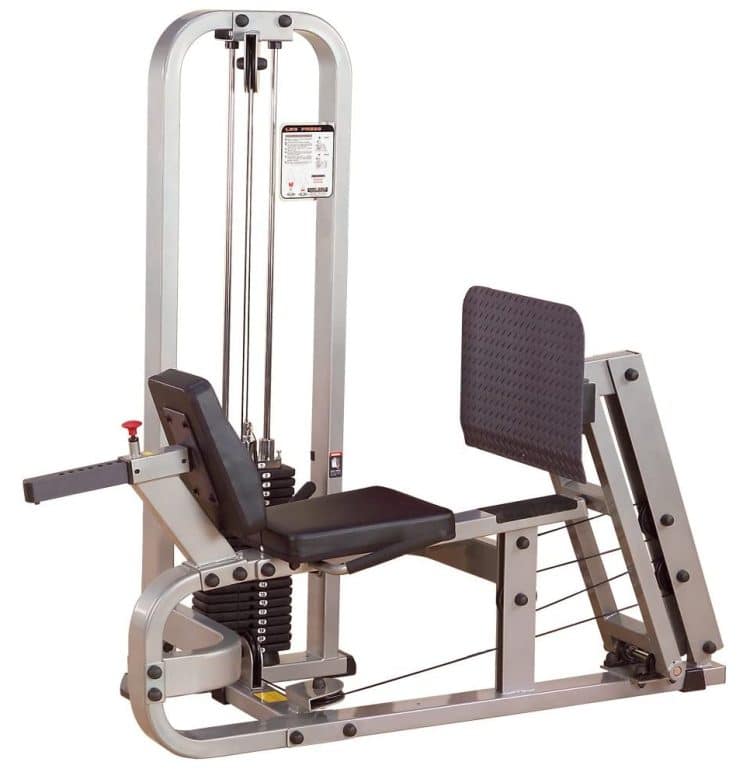
With this type of leg press, the load when empty is very low – probably no more than 20 pounds. Because the weight moves horizontally on rods and rollers, there is no gravity and very little friction to overcome. You’re not even lifting your body weight or the weight of your legs.
Some machines are slightly angled, so the starting weight is somewhat higher, but we’re only talking a few more pounds.
This type of machine is generally not much good for heavy training. The weight stacks don’t tend to be very big, and there is so little added resistance that a strong person should have no problem putting the pin at the bottom and cranking out lots of reps.
This is another reason that horizontal leg press machines are favored by beginners.
In terms of the amount of weight you’re actually lifting, this will depend on the pulley system employed by the machine.
For example, with a single pulley, the weight and the force required to move it would be roughly the same. But, with a more complex pulley system, much less effort is needed to move the weight. Pulley systems vary from manufacturer to manufacturer and could reduce the weight you lift by 30-50%.
Pivot Leg Press
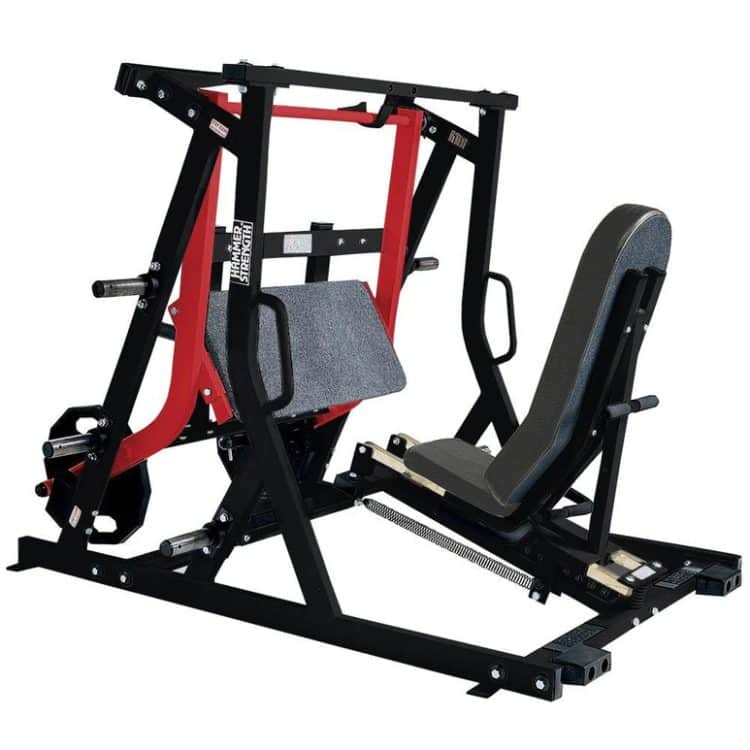
Pivot leg presses are also known as squat leg presses because they mimic the muscle action and strength curve of squats more closely. With this type of machine, the weight is light at the start of the rep and then increases as you push your feet (and the weight) away from you.
This produces a more natural-feeling movement than other types of leg press, which is why this exercise is popular with athletes. Some machines even have unilateral/separate footplates so you can train one leg at a time.
Regarding starting weight, pivot leg presses vary as other leg presses do. For example, the weight at the beginning of the movement can be as low as 10 pounds or as high as 50-100. The end weight depends on the length of the lever and the position of the fulcrum (pivot point).
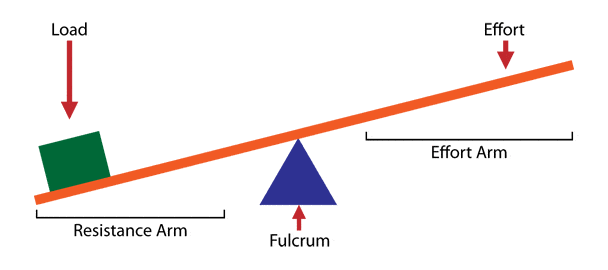
In simple terms, the closer the weight is to the fulcrum, the less effort will be needed to lift it. However, pivot leg presses usually have bent levers, so the resistance increases throughout the rep, peaking as your legs reach full knee and hip extension.
So, how much of the weight are you lifting on a pivot leg press? The answer is it varies throughout your rep.
Incline Leg Press
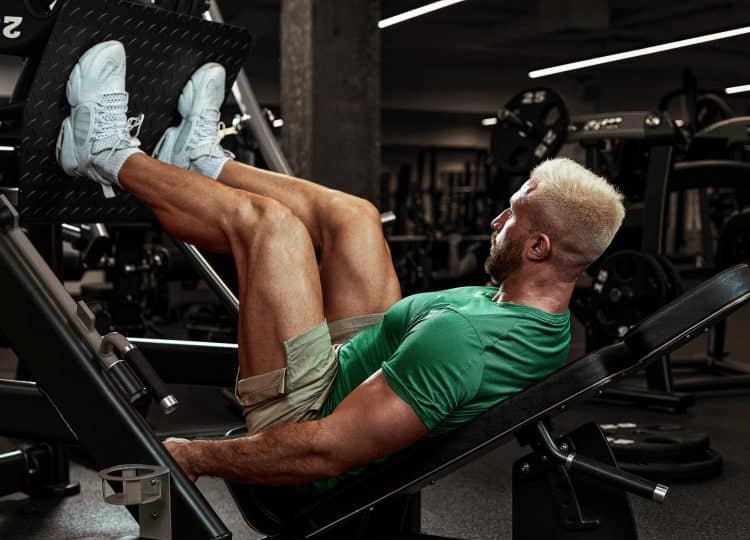
Of all the leg press machines, the incline leg press usually allows you to lift the most weight. That’s because the load is set up to move at an angle rather than vertically. This makes a significant difference in the amount of force required to lift the weight.
Because of the angle, you end up lifting about 70% of the weight on an inclined leg press.
So, if you load 220lbs/100kg on your incline leg press, you end up lifting about 154lbs or 70kg. However, this does NOT take the weight of the carriage into account. Depending on the model you are using, this could add 100 or more pounds to the load.
Vertical Leg Press

The vertical leg press is so-called because the weight carriage moves straight up and down, i.e., vertically. The carriage is guided by rails, and there are no pulleys or other mechanical advantages to be had.
As such, when you do vertical leg presses, whatever the combined weight of the carriage and plates are is how much you are lifting.
On the downside, vertical leg presses can put a lot of stress on your lower back, especially at the bottom of each rep. You need excellent hip mobility to perform this exercise with perfect technique.
However, the vertical leg press is the only type of leg press machine that requires that you lift 100% of the weight.
Hack Squat
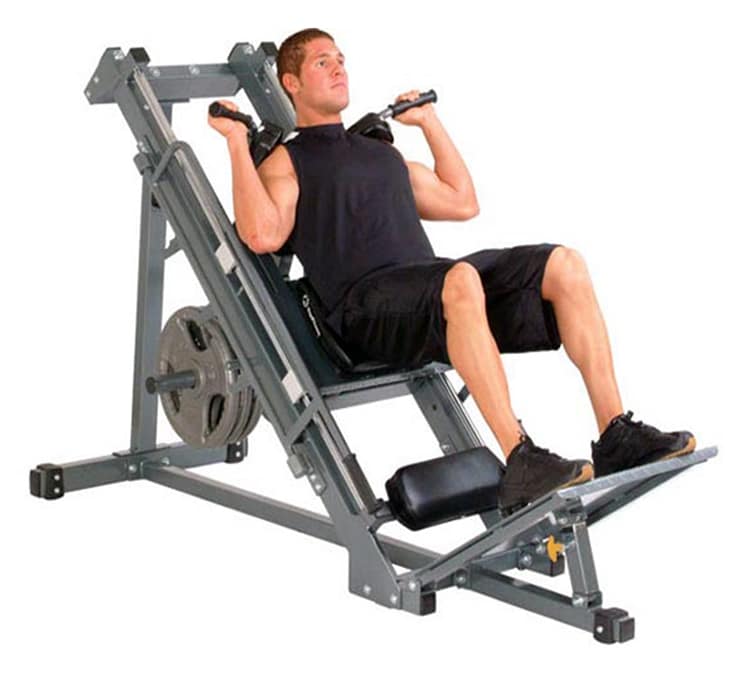
The hack squat is basically an inverted incline leg press. So, because you’ll be working at an angle, you end up lifting about 70% of the weight loaded on the carriage. However, despite these similarities, the hack squat tends to feel much harder than the leg press.
That’s because when you do hack squats, you’re not only lifting the weight of the carriage and plates but much your body weight, too. Also, your feet will probably be close together and not far in front of your hips. This emphasizes your quads while disengaging your hamstrings and glutes.
With fewer muscles producing force, 200lbs on a hack squat will feel much heavier than 200lbs on an incline leg press.
Hack squat carriages range from 80-100lbs, depending on the model and manufacturer. As with leg presses, this information should be stamped on the machine’s information panel or be available from the manufacturer.
Does Any of This Really Matter?
There is a reason that strength sports like powerlifting and Olympic lifting use standardized equipment – it makes it much easier to judge one athlete’s performance against another. If competition barbells we different weights or lengths, or weight plates were different heights, it would be impossible to have a fair competition.
In contrast, leg pressing is NOT an Olympic sport, so it doesn’t really matter if the carriage on one leg press weighs more than another or the angle of the guide rods changes how much weight you are actually lifting.
So long as you overload your muscles, you’ll get stronger, whether there are 250lbs or 350lbs on your machine.
Because empty leg carriage weights tend to vary, most people don’t even bother to count them when they’re working out how much they’re lifting. They just count weight plates. So, if you load 200lbs onto the leg press machine, that’s the number you record in your training diary.
That said, if you go to a new gym and use the leg press, you should start a little lighter than usual just in case the carriage is heavier than you are used to.
Similarly, you cannot compare your weights on a hack squat to an incline leg press or a seated leg press to a vertical leg press. The position of your body and the angle at which the load moves also affect the amount of force required to lift the weight.
So, while the weight of your leg press may be interesting to know, it’s probably not all that important, especially if you have no intention of comparing your performance from one machine to another.
Related:
- How Much Does A Deadlift Bar Weigh?
- How to Weigh Yourself Without A Scale
- How Much Does A Hex Bar Weigh?
- Different Types of Barbells You Should Know About
- Best Barbell Exercises for Strength, Size, and Power
How Much Does an Empty Leg Press Weigh?
The leg press is an excellent exercise for developing muscle strength and size, but it’s not so good for testing strength. Different machine designs, the type of leg press, the weight of the plate carrier, and the angle of movement all affect how much weight you are really lifting.
Because of this, most people do not consider the weight of an empty leg press when tracking their workouts. Instead, they just count the weight they load onto the machine.
For example, if someone brags about a 500lbs leg press, they usually mean they loaded the leg press machine with 500lbs. They have not stopped to calculate the weight of the carriage or the angle of movement to determine precisely how much they’re lifting!
So, if you want to compare your strength, barbell exercises are best. Use a standard 20kg/45-pound bar, and don’t forget to include the weight of your collars in your final total.


